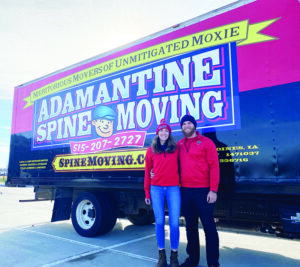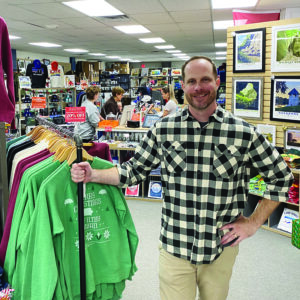Location, location, location
1/5/2022Location, location, location. The old adage says it is everything in real estate and business. However, sometimes business owners find what might have been a great location at one time no longer fits their needs. COVID-19 impacted how many business owners do business — and where they do business. An increase in remote work reduced space needs for some companies, and, despite the pandemic, some businesses found success in moving to locations more conducive to growth.

Cliff and Emily Wallace of Adamantine Spine Moving say businesses have moved more of their belongings into storage than out as they relocate to smaller spaces.
Factors to consider when choosing a location
Jake Fox from the Virgin Group created a list of the six most important factors to consider when choosing a location for a business. That list includes accessibility, security, competition, business rates, the area’s skill base, and potential for growth. These factors cover a wide range of variables a business might need to consider in their day-to-day operations.
• Accessibility: For many businesses, proximity to transportation links like major roadways is vital. Not only do they need to be easily accessible for deliveries, but also for customers and employees.
• Security: Some locations may be more susceptible to crimes than others, which not only poses a concern but can also cost the business more in insurance premiums and additional security measures.
• Competition: Close proximity to the competition may be an advantage or disadvantage. Too much competition in an area can offer too many choices for the consumer; however, a unique offering may draw customers from the area’s base.
• Business rates: Business owners must consider the cost of doing business at a location. Rent, utility, taxes, deposits — and some more obscure costs like parking — will vary by location.
• Skill base: Employees can be a business’ greatest asset, which is why it is important to consider the area’s workforce. Can the location draw the needed employees with the talent and skills needed?
• Potential for growth: Thought needs to be given to whether the business will stay in one place long term or need to expand and grow elsewhere.
Each business has a unique set of needs and priorities, and no one location can meet every need. A thorough evaluation of a location’s pros and cons can help prevent the need for a costly move in the future. The right location will meet the needs of the customers and increase the likelihood of success and growth for the business.

Becky Pospisal found that moving her business, The Knotty Nail, opened the doors to a new group of customers and benefitted from being near other retail shops.
The changing downtown hub
Downtown hubs used to be able to meet the needs of a slew of businesses. Large office buildings draw hundreds of employees who frequent the local coffee shops on their way to work, eateries when it is time to grab a bite during the lunch hour, gathering places for after-work socializing, and a variety of businesses for running quick errands.
But then March 2020 arrived, and the landscape of downtown business changed. The ensuing lockdown shut down many in-person businesses. Restaurants were forced to close, and some offices shut down and required employees to work remotely — for months. As businesses began to re-open and call employees back to the office, the economy began to recover. However, the way business is conducted has fallen into a new “normal.”
Many businesses have adopted a hybrid work model with some work being completed remotely. The traditional office building with floors of cubicle spaces isn’t needed as much as it once was. Many work meetings, projects and collaborations have been moved online out of convenience.
With fewer people commuting to work, some businesses — especially restaurants — are struggling to rebuild their customer base. The recent closure of Java Joes downtown is an example. In an April interview with another media outlet, Michael Larsen, the general manager of downtown Java Joes, attributed the decision to the impact of COVID on downtown businesses.
Making the move
The people at Adamantine Spine Moving, an Iowa City-based moving company with services in Des Moines, have found that people are moving out of cubicles to work wherever they like. In fact, some businesses are moving their stuff into storage.
“We have moved a lot of businesses into storage, but we haven’t been moving a ton of them out yet,” said Cliff Wallace from Adamantine. In the age of COVID, offices are using the moment to downsize, move out, and spread out.
Wallace says the company has seen an increase in residential moving that reflects the current work landscape. Cliff and Emily Wallace of Adamantine say the pandemic has spurred many people to relocate. Whether it be to move closer to family or for a cheaper cost of living, people are relocating out of downtown hubs to suburbs and smaller towns.
The Wallaces say the majority of businesses moving today have been office-type businesses. However, many small businesses located in Des Moines have also been moving in order to meet their needs.
In the age of COVID-19, businesses are getting great deals on new locations, according to the Wallaces. With all of the movement of individuals and businesses, property owners are trying to fill up their spaces — and offering great deals to do so. Lower rent, along with other lower business rates, can motivate a move. Moreover, a lower cost of living and commuting can motivate businesses and individuals to move.

John Bosley says moving his business, Bozz Prints, to Historic Valley Junction allows him to take advantage of foot traffic offered by the location.
When foot traffic matters
As advantageous as a move may seem, business relocation is not a guarantee of success. It is a risk to be carefully considered. John Bosley of Bozz Prints and Becky Pospisal of The Knotty Nail took on this risk. Both of these small business owners relocated to the Historic Valley Junction in West Des Moines.
John Bosley started working out of his basement in 2015. He was the head designer at another company before leaving to start his own business specializing in prints, posters and T-shirts. He finds inspiration in travel, architecture and the scenery of the Midwest. He was able to work his way out of his basement into his first physical location at Mainframe Studios in downtown Des Moines. While it was a big accomplishment for his business, Bosley says the location presented challenges for his type of business.
“We were open like once a month there, so when we were open at Mainframe we were only open for gallery nights or first Fridays,” he said. His success there led him to move elsewhere in order to grow his business.
“It was a big decision to basically take on open business hours and hire more staff… Now we have to have the doors open from a certain time to a certain time,” Bosley explained. Valley Junction presented an opportunity for Bosley to become a “retail entity,” which he couldn’t do at the studio he used to occupy. His current location has opened the door to more foot traffic. In addition to the new customer base at his new location, Bosley found some of his customers followed him after the move. Online purchases also make up a good portion of his business. Before the move, Bosley had created a strong online presence, and, when COVID hit, his online business increased.
Following closely in Bosley’s footsteps, Becky Pospisal made a similar journey. Her business, The Knotty Nail, grew out of her basement and moved into Mainframe for two years before arriving at her current location in Valley Junction. She also decided on the move to be more accessible to the public.
“Valley Junction is a really awesome historic district that gets a lot of foot traffic. There’s a lot of bars and restaurants and a lot of really established stores down here,” she said. The proximity to other businesses has proven to be a benefit. The Knotty Nail is a do-it-yourself art studio specializing in easy-to-do crafts. They offer in-person craft classes, a direct-to-home subscription box of crafts, as well as DIY kits that can be purchased online or in-store. Prior to her Valley Junction location, all of Pospisal’s customers were online, but now she gets in-store traffic from demographics she never reached before. Overall, Pospisal says her relocation changed the way she does business. She used to consider The Knotty Nail as a “destination,” but her location today provides more opportunity.
“It switched me from a place you buy a ticket and go to a place you can just pop by anytime,” she explained.
Changing times
COVID-19 demonstrated that some businesses were able to grow despite the adversity, while exposing the weaknesses of other businesses that struggled or closed. COVID also forced many businesses to incorporate technology in ways they hadn’t before — and some of those, such as remote work and online sales, have become the “new normal.” These changes, among others, have put new twists on the old adage that success is all about “location, location, location.”
“We really understand how important, as a business, it is to be comfortable in your space, to be located in a space that’s close to where most of your business comes from, and that’s comfortable for the employees,” said Emily Wallace. ♦
Tammy Pearson contributed to this story.
















Wow! What a great article! I love the mention of all of the Des Moines businesses!